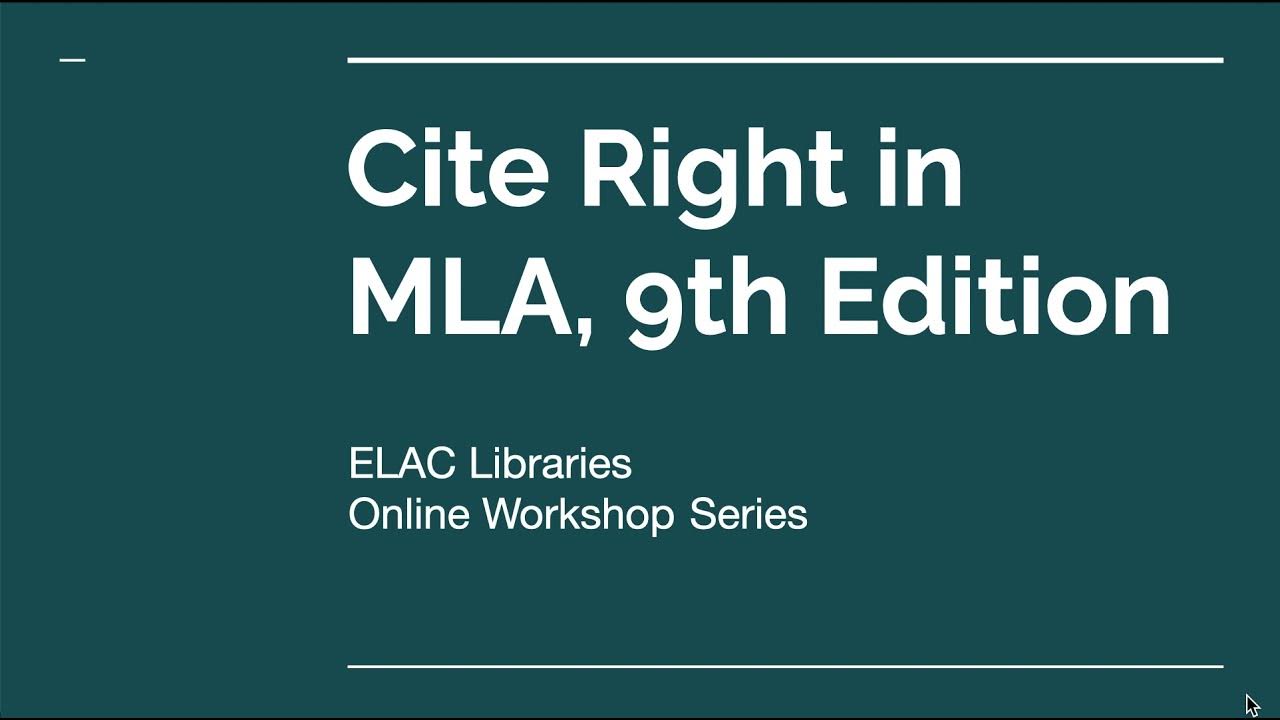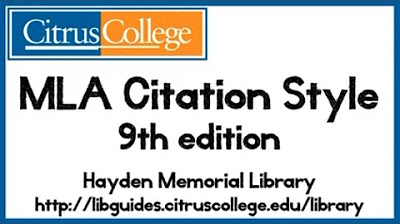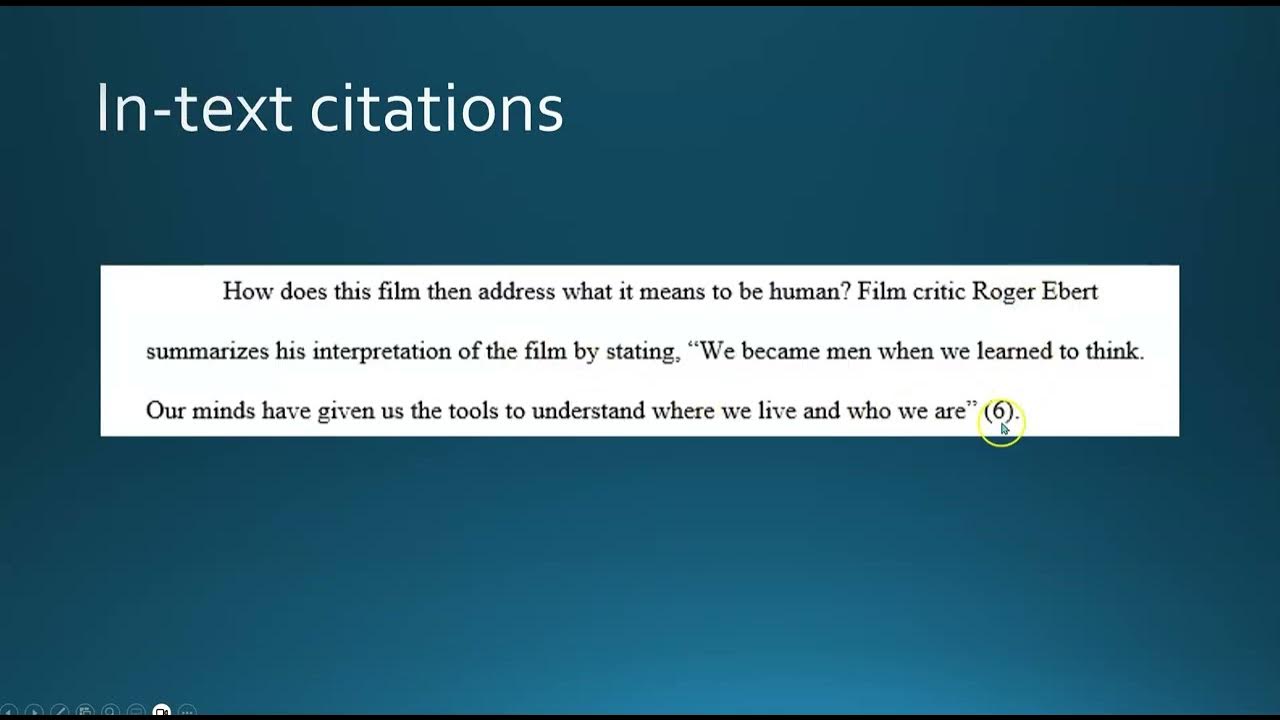In-Text Citations Made Easy: MLA 9th Edition
Summary
TLDRIn this video, Chelsea Seaburn walks viewers through the essentials of MLA 9th edition in-text citations. She explains why it's important to credit authors to avoid plagiarism and discusses the two-element citation format (author’s last name and page number). Seaburn covers parenthetical and narrative citation styles, handling multiple authors, corporate authors, and citing sources with no page numbers. She also explores situations like authors with the same surname. Throughout, she provides examples to demonstrate how to create accurate in-text citations. The video also previews upcoming lessons on creating works cited entries.
Takeaways
- 📚 MLA in-text citations are used to give credit to the author and avoid plagiarism.
- 🖋️ MLA 9th edition requires two elements for in-text citations: the author's last name and the page number.
- ❌ No comma separates the author's last name and the page number in MLA citations, just a space.
- 📖 In MLA narrative citations, the author's name is worked into the sentence, while parenthetical citations place the name and page number at the end.
- 👥 When citing two co-authors, list both last names separated by 'and'.
- 👨👩👦 For works with more than two authors, list the first author followed by 'et al.' to represent the others.
- 🏢 Corporate authors can be abbreviated in parenthetical citations for readability but written out fully in prose.
- 📄 When there is no author, use the title of the work in place of the author in the in-text citation.
- 🔢 If there are no page numbers, use an alternative location marker like section, paragraph, or chapter number.
- 🧑🤝🧑 If citing two different authors with the same surname, use their first initial to differentiate them in parenthetical citations.
Q & A
What is the primary purpose of using in-text citations in MLA format?
-The primary purpose of using in-text citations in MLA format is to give credit to the original author of the information you're paraphrasing or directly quoting. This helps avoid plagiarism by properly attributing the source.
What two elements are typically included in MLA in-text citations?
-MLA in-text citations typically include two elements: the author's last name and the page number where the cited information can be found.
How do you format an in-text citation with both the author's last name and the page number?
-In MLA format, the author's last name is followed by the page number without a comma, separated only by a space. For example: (Smith 45).
What is the difference between a parenthetical and a narrative in-text citation?
-A parenthetical citation places both the author's name and the page number within parentheses at the end of the sentence. A narrative citation integrates the author’s name into the sentence itself, followed by the page number in parentheses.
How do you handle MLA citations when a source has two authors?
-When citing a source with two authors, include both last names separated by the word 'and.' For example: (Lemmerie and Ombrebatch 5).
What should you do when citing a source with more than two authors?
-When citing a source with three or more authors, use the first author's last name followed by 'et al.' For example: (Nickerson et al. 78).
How should you cite a corporate author or organization in MLA format?
-When citing a corporate author, use the full name of the organization in the in-text citation. If the name is long, MLA allows using a shortened version, such as a noun phrase that clearly identifies the organization.
What do you do if there is no known author for the source?
-If there is no known author, MLA format suggests using the title of the work as the author element in the citation. You may abbreviate the title if it's long, focusing on the first main noun.
How do you cite sources that do not have page numbers in MLA format?
-For sources without page numbers, MLA recommends using another location marker, such as a chapter, section, or paragraph number, and labeling it accordingly. For example: (Smith, ch. 2) or (Jones, sec. 4).
How should you handle citations for different authors with the same last name?
-When citing different authors with the same last name, include the first initial before the last name to differentiate between them. For example: (N. Baron 67) and (J. Baron 89).
Outlines

Esta sección está disponible solo para usuarios con suscripción. Por favor, mejora tu plan para acceder a esta parte.
Mejorar ahoraMindmap

Esta sección está disponible solo para usuarios con suscripción. Por favor, mejora tu plan para acceder a esta parte.
Mejorar ahoraKeywords

Esta sección está disponible solo para usuarios con suscripción. Por favor, mejora tu plan para acceder a esta parte.
Mejorar ahoraHighlights

Esta sección está disponible solo para usuarios con suscripción. Por favor, mejora tu plan para acceder a esta parte.
Mejorar ahoraTranscripts

Esta sección está disponible solo para usuarios con suscripción. Por favor, mejora tu plan para acceder a esta parte.
Mejorar ahoraVer Más Videos Relacionados
5.0 / 5 (0 votes)






